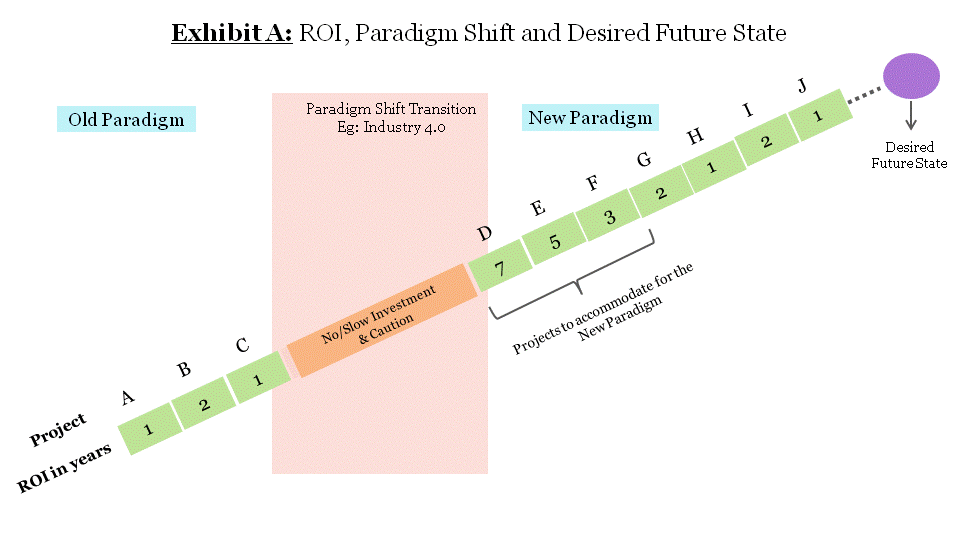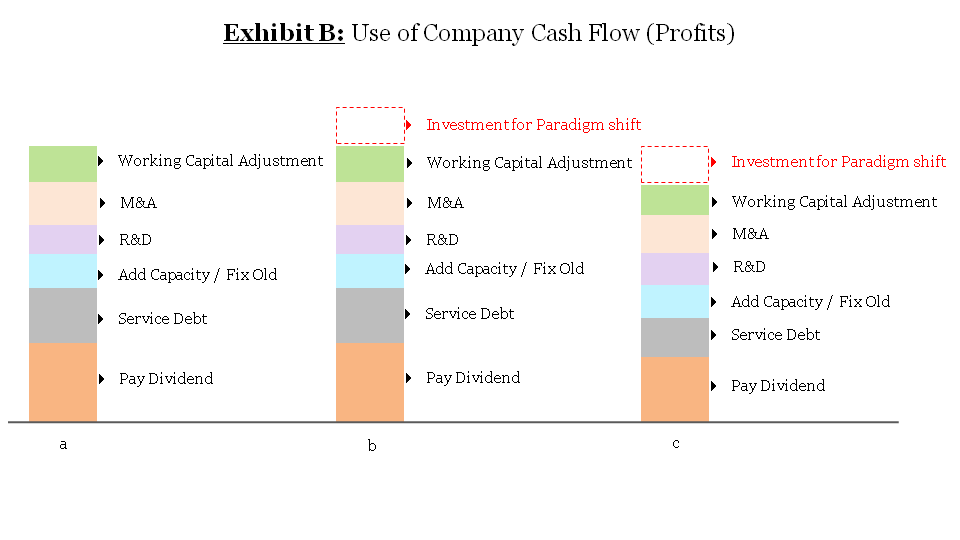Key considerations for investment in new technology
Technology change is constant in today’s world! This is true for manufacturing as well. Let’s talk about the relation between New Technology, ROI and Desired Future state and the key considerations for investment despite short term pains. Please look at Exhibit A.

Consider a paradigm shift that occurred due to ERP-MES with the advent of software in the ’80s-’90s (not shown on the timeline), followed by a period of ambiguity around the new paradigm. For the most part, those who made timely investments towards these new technologies, saw positive changes and reaped benefits in terms of projects (A to C), reaching favorable ROI.
Around point C, the manufacturing world started to talk about – THE PARADIGM SHIFT ! Industry 4.0 (i.e. the trend towards automation and data exchange including cyber-physical systems (CPS), the internet of things (IOT), industrial internet of things (IIOT), cloud computing, cognitive computing, and artificial intelligence.)
The period highlighted from C to D is marked by ambiguity for many of us in the manufacturing world. What are these new technologies? How do they apply to us? Will we be able to benefit from these? What skill sets will be required internally to develop these? Who will we partner with to develop these for our application? What will be the investment required? What will be the ROI? Does it align with our long term goals?
Eventually we realize that this change is inevitable; however, it needs additional knowledge, investing in prototypes, changing existing legacy systems, developing new skills, developing new partners/supplier network, etc. It needs new INVESTMENT! This period from D to F does not have good ROI, but is essential to enable projects of ongoing improvements and projects with favorable ROI periods G to J. So what makes us take the leap of faith and do steps D to F even though there is no guarantee of success? It’s what I call the Desired Future State.
So, what is this Desired Future State? It’s a state once reached will generate superior business value in one or more of the following;
- Customers – higher customer satisfaction in terms of service, quality, cost and/or product offerings
- Better competitive edge
- Employees – new skills, better careers/opportunities, higher job satisfaction
- Shareholders – higher return on investments
- Society – positive impact on our communities and environment
- Company – last but not the least, it moves the company closer to its purpose/mission
One can see it requires progressive leadership and passion to conceive this desired future state. Starting with building the right team, securing finances, taking calculated short-term risks, betting on not so good ROI projects, and course-correcting along the way. Most importantly, it requires leading through change.
Securing finances is usually one of the biggest challenges in making this paradigm change a reality. Please see exhibit 2 for finance scenarios: Current state (Part a). Generate new profit and savings streams to fund the paradigm shift (Part b). Re-allocate current profits to fund the new initiatives (Part c).
In recent times established companies have struggled between C & D while new entrants (Amazon, Uber, Airbnb) have taken advantage of the advancements in the internet/digital world, spending through the phase from D to F to innovate, develop new systems & technologies and gain new customers. The ROI for the first few years is not great, there can even be a heavy loss on their P&L but once they pass point F, they will be well on their way to their Desired Future State; win over more customers and continue to outdo their competition.
Another example of this is Blockbuster which stayed with brick & motor and DVD/CD delivery model (between C & D) and did not move to online streaming. But Netflix saw the coming trend, customer need, the technology and envisioned a desired future state that could bring great value to the customer. This created a great competitive advantage for Netflix and we all know what happened to Blockbuster. Blockbuster knew about the online streaming technology but refrained from investing in it because this had a longer ROI time-frame and they also made a significant income in late CD/DVD return fees. This resistance to investment in new paradigm cost Blockbuster their existence.
Also, there is something to be said about who is ahead and reaches the desired state first and builds the first movers advantage (Netflix vs. Amazon Prime in online streaming wars).
Key Points:
- Recognize a paradigm shift in technology that affects your line of business and re-organize to take advantage of it, in spite of the short term pain. It is worth the risk to be the first mover, to gain an advantage over the competition and wow the customer. In the absence of courage to change, we will stagnate, eventually fall behind or even cease to exist as a company.
- Have a desired future state, a strong and passionate vision for where to take the company. This will help make the mid-long term bets in terms of investments, reorganization, reskilling and overall direction.
- ROI is just a financial efficiency metrics in terms of the use of capital. I believe it is better to invest in projects that help you reach your desired future state and provide great value to all your stakeholders. And it is key to strategically organize the financials to pay for a paradigm shift in technology.
Further Reading: 10 Rules Behind Amazon’s Success You Can Use on Your Digital Transformation Journey
![]() This article was written by Amit Agarwal and originally it was published here. He is an Industrial Strategy Manager with EssilorLuxottica in the operations division and with experience in implementation of factory automation previously as Automation & IT Manager with the same company. He has 20 plus years of experience in Engineering, IT, Lean, Continuous Improvement and Strategy. He is especially passionate to implement the lessons learned from new generation companies the likes of Amazon, Google, Tesla, Airbnb, Apple in manufacturing and supply chain in terms of innovation mindset, digitization, artificial intelligence & industry 4.0.
This article was written by Amit Agarwal and originally it was published here. He is an Industrial Strategy Manager with EssilorLuxottica in the operations division and with experience in implementation of factory automation previously as Automation & IT Manager with the same company. He has 20 plus years of experience in Engineering, IT, Lean, Continuous Improvement and Strategy. He is especially passionate to implement the lessons learned from new generation companies the likes of Amazon, Google, Tesla, Airbnb, Apple in manufacturing and supply chain in terms of innovation mindset, digitization, artificial intelligence & industry 4.0.
